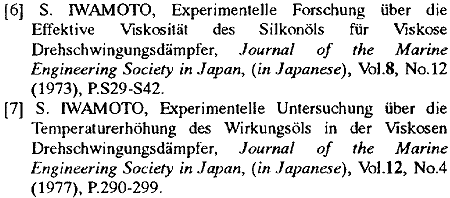[3] If the viscosity of the filling silicone oil is originally decided, the optimum clearance exists in proportion to its viscosity.
[4] The dampers of the clearance dimension under 0.5 mm in the range of the low viscosity of the silicone oil has the more effect of the reduction on the resonant torsional amplitude than those of the clearance dimension of 0.5 mm obtained from BICERAS empirical formula. But the optimum clearance dimension of the damper filled with the high viscosity of the silicone oil is nearly 0.5 mm.
[5] The absolute value of the complex coefficient of torsional viscous damping have approximately the tendencies to decrease with the increase of natural frequency and to increase with the decrease of damper coefficient.
REFERENCES
[1] K. WABAYASHI, Y. HONDA, T. KODAMA, S. IWAMOTO, The Dynamic Characteristics of Torsional Viscous-Friction Dampers on Reciprocating Engine Shaftings, SAE 1992 Transactions, Journal of Engines, Section 3, No.921 726, Vol.101 (1993), P.1734-1754.
[2] J. C. Georgian et al., Torsional Viscous-Friction Dampers, Transactions of American Society of Mechanical Engineers, Paper No.48-A-67 (1949), P.389-399.
[3] D. HIRAYAMA, S. IWAMOTO, Characteristics of a Torsional Vibration Damper of Viscous-Shear Type Attached to a Multi-Cylinder Diesel Engine. Transactions of the Japan Society of Mechanical Engineers, (in Japanese), Vol.27, No.180, (1961). P.1377-1387.
[4] T. SEKl, T. SAJTO, S. IWAMOTO, An Experimental Study on the Absorbed Energy by the Viscous Torsional Vibration Damper, Bulletin of Science and Engineering Research Laboratory, Waseda University, (in Japanese), No.30. (1965), P.51-57.
[5] T. SEKI, T. SAITO, S. IWAMOTO, Characteristics of a Viscous-Torsionai Vibration Damper Attached to a High-Speed Multi-Cylinder Diesel Engine. Bulletin of Science and Engineering Research Laboratory, Waseda University, (in Japanese). No.35 (1966). P.31-39.

[8] S. IWAMOTO, Study on the Effective Viscosity of Working Oil in Viscous Torsional Vibration Damper of Diesel Engine, Second Report: Complex Viscosity of Working Oil in Damper of High Speed Engine, Journal of the Marine Engineering Society in Japan, (in Japanese), Vol.18, No.10 (1983), P.795-800.
[9] S. IWAMOTO, T. YONEZAWA, Y. MUKAWA Study on the Effective Viscosity of Working Oil in Viscous Torsional Vibration Damper of Diesel Engine, Third Report: Complex Viscosity of Working Oil in Damper of Low Speed Engine, Journal of the Marine Engineering Society in Japan, (in Japanese), Vol.18, No.12 (1983). P.975-981.
[10] K. WAKABAYASHI, S. IWAMOTO, K. SHIMOYAMADA Analysis of Vibrations of Reciprocating Engine Shaftings by Transfer Matrix Method. The Fourth Report: Torsional Vibration Stress of a Crankshaft with a Viscous Fluid Damper, Journal of the Marine Engineering Society in Japan, (in Japanese), Vol.19, No.1 (1984). P.24-33.
[11] S. IWAMOTO et al., The Development of the Torsional Vibration Damper of Viscous Shear Type with Controllable Elasticity Effect. Journal of the Marine Engineering Society in Japan, (in Japanese), Vol.21, No.3 (1986), P.215-222.
[12] H. OKAMURA et al., Development of High-Viscosity Damper, Society of Automotive Engineers of Japan Review, Vol.8. No.4, (1987), P.80-83.
[13] T. ASAMI, et al., Damping Characteristics of Fluid Dampers, -Oil Film Damper, Oil Damper and Air Damper-, Transactions of the Japan Society of Mechanical Engineers, (in Japanese), C. Vol.57. No.534, No.90-0828 A (1991), P.437-445.
[14] Y. SATOH, The Reductive Performance of the Dynamic Absorbers and Dynamic Properties of the Viscoelastic Absorber Elements. Transactions of the Japan Society of Mechanical Engineers, (in Japanese), C, Vol.57, No.534, No.90-0790 A (1991), P.446-452.
[15] H. SHIMIZU, Viscous Type Torsional Damper for Engine Crankshaft, Internal Combustion Engine, (in Japanese), Vol.30, No.3 (1991), P.33-39.
[16] T. ASAMI et al., Effect of Compressibility of Oil on an Oil, Transactions of the Japan Society of Mechanical Engineers, (in Japanese), C, Vol.58, No.549, No.91-1344 (1992), P.1592-1600.
[17] Y. SATO et al., Suppression of Torsional Vibrations by a Partitioned Hollow Rotor Containing Liquid, Transactions of the Japan Society of Mechanical Engineers, (in Japanese), C, Vol.59, No.557, No.92-0858 (1993), P.17-23.
[18] K. WAKABAYASHI, Y. HONDA, T. KODAMA, K. SHIMOYAMADA, S. IWAMOTO, The Effect of Typical Torsional Viscous-Friction Damper on the Reduction of Vibrations in the Three Dimensional Space of Diesel Engine Shafting. SAE 1997 Transactions, Journal of Engines, Section 3, No.932009, Vol.102 (1994), P.1852-1872.
[19] Y. SATO et al., Suppression of Torsional Vibrations by a Sectored Hollow Cylinder Containing Liquid, -Observation of Surface Wave-, Transactions of the Japan Society of Mechanical Engineers, (in Japanese), C, Vol.59, No.569. No.93-0939 (1994). P.44-49.
[20] I. SHIMODA, Study of High Viscous Damper, -Modeling of Viscoelasticity and Proposition of Design Method-. Transactions of the Japan Society of Mechanical Engineers, (in Japanese), C, Vol.60, No.570, No.93-1098 (1994), P.476-481.
[21] Y. SATO. Suppression of Torsional Vibrations by a Sectored Hollow Cylinder Containing Liquid, -Effect of Coriolis Force-. Transactions of the Japan Society of Mechanical Engineers, (in. Japanese), C, Vol.61, No.587, No.94-1776 (1995), P.2839-2845.
[22] G. YAMADA, Torsional Damper, Internal Combustion Engine, (in Japanese), Vol.5, No.48 (1996), P.68-69.
[23] Y. YAMAZAKI, et al., Experimental and Computation Analysis for Torsional Vibration Crankshaft System with Viscous Torsional Damper, Society of Automotive Engineers of Japan, Proceeding of 1999 Autumn Convention, (in Japanese), No.46-99. No.9933943 (1999), P.13-16.